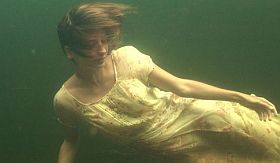


Maciej Drygas: Abu Haraz/ 2
In Warsaw, at the Planete+ Doc Film Festival, I was asked to talk about film critic, especially the one about documentaries. I did so and together with a dozen of workshoppers, the new film of Maciej Drygas was screened. I made a call for reviews to add to the one I had already done, see below. Polish Marta Tarnowska, polish sociologist and anthropologist, made one, which comes here and which perfectly illustrates how another perspective on the film can widen your understanding:
The camera eye opens and starts to observe carefully the severe yet harmoniously poetic daily-life routine of the humans and other animal species habiting the fertile lands by the banks of the Blue Nile river. The ‘other animal species’ part of the narration is not marginal, but just as important as the human one in this story-telling. We see a world where a human is just another symbiotic element of the natural system.
Maciej Drygas and Andrzej Musiał successively visit Abu Haraz for seven years. They spend there one month each year 2005-2012, observing the natural rhythms that organize life in Abu Haraz, a small village where people make their living from agriculture and livestock herding. We enter an idyllic and maybe even slightly romanticized yet appealing world, where the notions of linear, clock-measured time, space and the basic for the westerners binary distinctions like ‘richpoor’
do not structure nor organize the social world.
We watch an absolutely magical scene where the school-children in the classroom are being taught by their teacher the meaning of the word ‘poor’. It seems that none of the school-children had previously had the chance to use this category to describe anyone, although in the eyes of many westerners all of them would probably be categorized as ‘poor’. Apparently, there are no people considered as such among them. All of them are affluent. It tells us something important about the anglo-american term ‘poor’. It shows us clearly that the notion of ‘poor’ does not describe ‘objective’ reality. ‘Poor’ is relational. It points to the relation between means and ends. Marshall Sahlins, an
american anthropologist, brilliantly explained it in one of his articles about the concept of ‘affluence’. To accept that the original societies are affluent is ‘therefore to recognise that the present human condition of man slaving to bridge the gap between his unlimited wants and his insufficient means is a tragedy of modern times.’
Sudan is a relatively young, postcolonial country. Its frontiers were arbitrarily delineated without any respect given to the local ethnical, cultural and political context. The power was given mainly to the muslim Arab elites, ignoring other ethnic and cultural groups. Obviously, this immediately produced multiple military conflicts. Access to the natural resources like water and control over the oil fields are the main drives of the conflicts. In the period of seven years when Drygas and Musiał repeatedly visit Abu Haraz, the Second Sudanese Civil War reluctantly comes to an end resulting in
the secession of South Sudan (2005 autonomy, 2011 independence). It is estimated that around 180 000 – 450 000 people died and 1,7 millions were displaced or lost their shelter as a consequence of the ongoing war in Darfur. The western frontier with Chad is in conflict as well as the Eastern Front and Blue Nile, where ‘popular consultations’ about potential succession from Sudan are to be held.
Meanwhile, in Abu Haraz shown by Drygas signs of military conflict(s) are scarce. Drygas does hardly inform us about the regional or national politics. We can only sense the air of conflict because of some groups of men shouting some disturbing, revolutionary slogans. Lack of explanation of the political situation is a conscient and well-argumented choice. Many of the habitants of the ‘Nile culture’, Abu Haraz included, identify themselves much more with the local community, village or tribe than with the artificial postcolonial pseudonational-state Sudan.
National identities have not developed. Moreover, many of them probably do not understand the political issues either, just as an unprepared viewer. Nevertheless, the pseudonational-state Sudan has a vital (more adequately put would be ‘deadly’) influence on their lives. As a result of Khartoum’s decision, a huge dam Meroe was built on the Nile near Amre. As a consequence, a huge area was flooded and 70 000 people (including 80 from Abu Haraz) lost their homes and homeland, habits, cultures and ancestors’ rests and were forcibly displaced to villages artificially built for this
purpose in the middle of the desert. The people from Abu Haraz are taken to Wadi Mugaddam, they are provided houses with electricity and tv. Yet, they call their new place a dead place and they claim they feel dead inside as well. It is hard to admire this work of ‘modernization’ and ‘development’. We can see them daydreaming, suspended between the tv-converting them into aspirational consumers of new identities and the dreams of the ‘paradise lost’, memories of the past, dreams of Abu Haraz and the traditional life rhythm they adapted to over generations.
